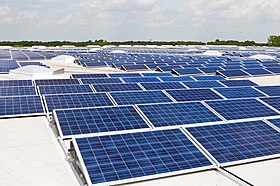Photovoltaic module
 |
 |
| Solar PV modules (top) and two solar hot water panels (bottom) mounted on rooftops |
Solar panel refers to a panel designed to absorb the sun's rays as a source of energy for generating electricity or heating.
A photovoltaic (PV) module is a packaged, new types of solar panels have been occuring, some of the most efficient solar panels are connect assembly of typically 6×10 photovoltaic solar cells. Photovoltaic modules constitute the photovoltaic array of a photovoltaic system that generates and supplies solar electricity in commercial and residential applications. Each module is rated by its DC output power under standard test conditions (STC), and typically ranges from 100 to 365 watts. The efficiency of a module determines the area of a module given the same rated output – an 8% efficient 230 watt module will have twice the area of a 16% efficient 230 watt module. There are a few commercially available solar modules that exceed 22% efficiency and reportedly also exceeding 24%. A single solar module can produce only a limited amount of power; most installations contain multiple modules. A photovoltaic system typically includes an array of photovoltaic modules, an inverter, a battery pack for storage, interconnection wiring, and optionally a solar tracking mechanism.
The most common application of solar panels is solar water heating systems.
The price of solar power has continued to fall so that in many countries it is cheaper than ordinary fossil fuel electricity from the grid (there is "grid parity").
Photovoltaic modules use light energy (photons) from the Sun to generate electricity through the photovoltaic effect. The majority of modules use wafer-based crystalline silicon cells or thin-film cells. The structural (load carrying) member of a module can either be the top layer or the back layer. Cells must also be protected from mechanical damage and moisture. Most modules are rigid, but semi-flexible ones are available, based on thin-film cells. The cells must be connected electrically in series, one to another. Externally, most of photovoltaic modules use MC4 connectors type to facilitate easy weatherproof connections to the rest of the system.
...
Wikipedia
